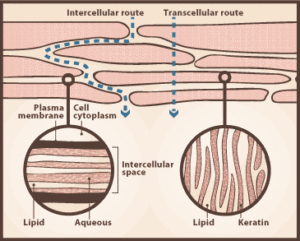Patients often forget to take their medicine, and even the most faithfully compliant get tired of swallowing pills, especially if they must take several each day. Additionally, bypassing the gastrointestinal (GI) tract would bypass the GI irritation that frequently occurs and avoid partial first-pass inactivation by the liver.
I started reading about transdermal nutrition about twelve years ago. I had been taking pharmaceutical and supplement pills daily for a chronic condition for over a decade and I just wanted to be done with pills, supplements or otherwise. I didn’t even care how great the supplement was. Not only was I tired of standing at the kitchen counter trying to swallow a handful of pills, I was aware that my gut had been annihilated from long term antibiotic use over the previous decade and I wasn’t sure much of what I was ingesting was properly absorbing. I didn’t want my hard earned money being flushed down the toilet, literally and figuratively.
This is when I started researching whole food patches. I knew that if the nicotine patch and birth control patch 100% worked, other types of patches would likely work too. The patches seemed so much more convenient and possibly better than ingestible supplements. I had recently gone to a little IV clinic to try out one of their nutritional cocktails. Unlike ingesting the vitamins, the cocktail’s effects were smoother and longer lasting. When I started experimenting with supplement patches, I noticed the same thing. Instead of applying them daily, one a week felt sufficient. I loved that unlike ingesting a supplement, they are time-released, like an IV drip.
As an example, here is a look at the comparison of oral magnesium delivery (through the gut) and transdermal magnesium delivery (through the skin), it paints a picture of how the delivery works for supplements other than magnesium. Because the studies on magnesium are very clear and there are many, I thought I would share them:
How does the digestive system absorb magnesium?
Magnesium, through foods and traditional supplements, pass through the digestive or “gastrointestinal tract”. The gastrointestinal (GI) tract is essentially a journey of foods and/or supplements along a pathway:
- The mouth
- The esophagus or throat
- The stomach
- The small intestine
- The large intestine
The first steps in magnesium bioavailability through this pathway are breakdown by the mechanical action of chewing, and the digestive action of gastric acids found in the stomach. Following digestion, magnesium is largely absorbed in the small intestine. There magnesium passes from tiny “villi”, finger-like surfaces inside the small intestine, into capillaries, tiny blood vessels surrounding the small intestine.
Magnesium not absorbed in the small intestine continues to travel to the large intestine, where a small additional amount may be absorbed.
Typical magnesium absorption involves:
- 40% of magnesium intake absorbed in the small intestine
- 5% absorbed in the large intestine
- 55% leaving the body as waste
Depending on the type of magnesium ingested and the magnesium status of the individual, these figures can be higher or lower. Studies have shown overall absorption of magnesium in some individuals as low as 20%.
How is topical magnesium absorbed through the skin?
The skin, the largest organ of the body, has three primary functions:
- Temperature control
- Detoxification
- Barrier function
While one function of the skin, its barrier function, is to keep water and moisture in while keeping germs and toxins out, the skin’s other functions, temperature control and detoxification, could not occur if the skin was truly a complete barrier.
When you sweat, for example, you are both controlling your body’s temperature and naturally excreting toxins through your skin. If you can push out toxins, you can pull them in as well. One example of this phenomenon is that fact that a person who regularly uses underarm deodorant containing aluminum will actually show aluminum content in a fecal or urine test.
Does a high magnesium diet equal high magnesium absorption?
Ultimately, a great number of individual factors affect magnesium bioavailability in the individual, including factors such as nutrient filtration by the kidneys, and varying levels of absorption caused by age, stress, certain diseases and individual differences.
So levels of magnesium in the body are not determined simply by choosing the best-absorbed magnesium among dietary sources.
Though a person with healthy kidneys is adept at handling excessive magnesium intake — making magnesium toxicity a truly rare phenomenon — the body appears less adept at coping with a magnesium deficient state. A small amount of magnesium storage is available in the bones, yet deficiencies can occur after as little as one week of insufficient intake.
And influences on magnesium bioavailability are particularly a concern in cases of low dietary intake, according to Dr. Anton Beynen of the Utrecht Department of Human Nutrition at the State University, Netherlands.
“At low magnesium intakes, differences in magnesium absorption may be expected to influence magnesium retention and thus can either induce or abolish magnesium deficiency.”
For some people with issues that hinder magnesium absorption in the gastrointestinal tract, no amount of dietary or oral magnesium can compensate. One promising avenue that bypasses common digestive issues lowering magnesium absorption is that of transdermal magnesium.
Dr. Carolyn Dean, M.D., N.D. writes:
“I realized that many people can’t take oral magnesium because of the laxative effect. Therefore I began researching and then advising people to put supersaturated magnesium chloride-called magnesium oil on their skin to bypass the intestines; stimulate DHEA production that occurs in the skin; use it in baths and foot baths for muscle aches, joint pain, and foot pain and neuropathy.”
Magnesium intakes in industrialized nations are on a downward spiral, and medical studies linking deficiency to a range of conditions are growing. In these times, an adequate magnesium diet must take into account not just the “most absorbable” magnesium sources, but also individual differences that can prevent the absorption of magnesium from the diet.
Transdermal magnesium presents a new form of magnesium that bypasses absorption problems in the GI tract and side effects of oral magnesium, bringing the ability to achieve adequate magnesium levels within reach for the millions of people worldwide whose intake is insufficient.
A Definition of Dermal Absorption
In fact, many substances do pass into the body from the outer surface of the skin and into the circulation. To understand how this works, imagine a tightly woven fabric. While from a distance it may appear impervious, at close range it is actually highly porous. It is this porous nature of the skin, with its millions of tiny openings, that allows not only sweat and other toxins to escape, but also enables the absorption of some substances.
The process is known as dermal absorption. Once a substance passes through the outer layers of skin, it passes into the lymph and local vascular (blood vessel) system and soon after into the bloodstream.

While the exact mechanisms of skin transfer are yet to be completely understood, three routes of penetration have been hypothesized:
- Intercellular Skin Absorption, which occurs between the cells of the “stratum corneum”, the outermost layer of the skin
- Transcellular Skin Absorption, where substances actually pass through the skin cells themselves
- Skin Absorption Through the Follicles and Glands, also known as ”appendageal absorption”, which may also exhibit ”reservoir effects” in which substances may be stored within the glands for absorption over time
What is the history of transdermal delivery?
Humans have been using the skin as a direct pathway into the body for centuries, and only recently have we begun to understand the science behind it.
Many people are familiar with the healing properties of saunas, used quite often for detox and general well-being. Saunas are the closest modern equivalent to the ancient practice of “balneology”, a healing method that can be traced to antiquity.
Ancient treatments in fact involved a variety of transdermal therapies ranging from mineral baths, to herbal compresses, to mud packs, to steam and sweat lodges. These topical remedies were not limited to one culture, but were a part of many of the documented societies spread throughout the world.
- In Homer’s Odyssey he frequently mentions the bathing habits of his heroes, drawing repeated attention to the significance of the deed. In the tenth century Paul of Aegina, a great physician, discusses balneology in a medical text, specifically detailing various forms of mineral waters for different ailments.
- The city of Bath in England took its name from the hot mineral springs it contains. The traditional tale of its origins told of how the son of an ancient king contracted leprosy. After he was banished from the palace he found the mineral waters in Bath and returned miraculously healed of the disease.
- When Ponce de Leon and Hernando DeSoto sought the “Fountain of Youth” in the new world, many speculate that the exaggerated tales that arose referenced the healing properties of a mineral-dense geothermal spring. Prior to commercialization, these same hot springs were a place where the native Indian populations would bring their sick or wounded, and would fight viciously to protect what they felt was sacred ground.
More recent examples of topical and transdermal therapies can be found from the 18th through the early 20th century and eventually led to the technological advancements seen today. Throughout Europe, the skin as a gateway for medical therapy became increasingly popular in the late 18th century. In an age where open wounds often led to infection, topical remedies were favored over risky surgeries. For instance, soaking in sulfurous mineral baths became a widespread treatment for gout, which might otherwise have meant amputation.
Early editions of the United States Pharmacoepia (USP) contained several plasters, pastes applied with a cloth binding cover, which are precursors to current transdermal patches. Similarly, herbalists utilize compresses and ointments based on the healing properties of plants.
In the same way that modern science has not only verified but also capitalized on traditional knowledge of the power of herbs and plant constituents, ongoing studies today explore the mechanisms of skin absorption, gradually confirming the practices of healers from before written history. People in ancient Egypt used various natural products such as turmeric, natural oils, etc. for cosmetic purposes. These products were used in making salves, ointments, potions, and sometimes even patches.
Transdermal patches can offer a lot of benefits over any other form of drug administration. For example, http://optimisticmommy.com/vitamin-patches-a-good-alternative-to-pills/ suggest that these patches are easier to use, as well as, provides equivalent benefits (if not more) as that with oral vitamin intake. This is just one of the many reasons why you should be using transdermal patches. My wellness patches provide whole foods and herbs that are recognized by the body directly to the bloodstream through the skin from adhesive patches that you apply at bedtime or whenever you like. Feel free to browse my supernatural hydrogen bath here, whole food patches here. my topical magnesium oil here, and my supernatural oxygenated castor oil pack here.






